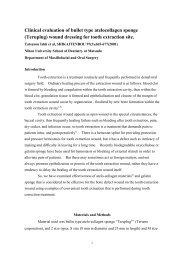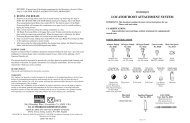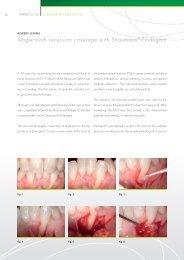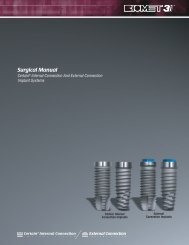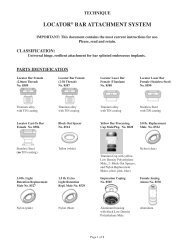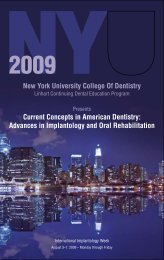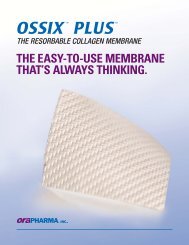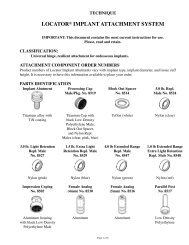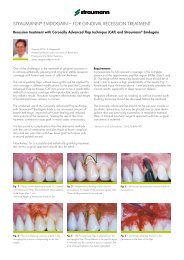Research Dossier
Research Dossier
Research Dossier
- No tags were found...
Create successful ePaper yourself
Turn your PDF publications into a flip-book with our unique Google optimized e-Paper software.
Surface Area Increase Due To Discrete-Crystalline-DepositionOf Nanometer-scale CaP CrystalsZach Suttin, Prabhu Gubbi, BIOMET 3i, Palm Beach Gardens, Florida, USAEuropean Association ForOsseointegration15th Annual Meeting (October 5–7, 2006, Zurich, Switzerland)IntroductionThis study estimates the increase in surface area (SA) dueto the deposition of nano-scale calcium phosphate (CaP)crystals onto a dual-acid-etched (DAE) implant surface.Materials And MethodsAtomic Force Microscopy (AFM) is used to quantify surfacemeasurement parameters of surfaces with nanometertopographical characteristics. In addition to the AFM datacurrently being generated, this study uses theoretical 3-Dmodeling to estimate the SA increase due to the depositionof nano-CaP crystals onto a DAE surface. The size, shapeand distribution of the nano-CaP crystals were based on thedimensions obtained from FESEM (JEOL Model 6700F)images. The crystals were modeled as ellipsoids with sizesranging from 20-80nm on the long axis and 10-39nm on theshort axis. Based on the FESEM imaging, the distributionsof crystal coverage considered for the analysis were classifiedas light (25-30%), medium (55-60%) and heavy (65-70%).Results And DiscussionThe calculated estimates for SA increase due to nano-CaPdeposition were 84%, 152% and 264% for the light, mediumand heavy crystal coverage, respectively. Furthermore,compared to a machined surface, the DAE treatment increasesthe implant SA > 50% (data on file), and it was estimated thatthe increase in implant SA with the addition of nano-CaP ontothe DAE surface ranges from 176% to 446%.ConclusionDeposition of nano-scale CaP crystals over a micron-scaleDAE surface significantly increases the overall SA andtopographical complexity.Percent30025020015010050084%SA Increase152%264%Light Medium HeavyCrystal CoverageRoughness Characterization Of Surface WithDiscrete-Crystalline-Deposition Of Nanometer-scale CaP CrystalsPrabhu Gubbi, Zach Suttin, Alexis Goolik, BIOMET 3i, Palm Beach Gardens, Florida, USAAcademy Of Osseointegration22nd Annual Meeting (March 8-10, 2007, San Antonio, Texas)IntroductionThe objective of this study was to characterize the surfaceroughness of polished titanium disks with nanometer-scalecalcium phosphate (CaP) crystals deposited by a newproprietary surface treatment called discrete-crystallinedeposition(DCD).Materials And MethodsTi (Ti-6Al-4V-ELI) disks, 20mm in diameter and 1.5mm inthickness, were machined and polished on one side to amirror finish (Control group). A group of polished diskswere deposited with nano-scale CaP crystals using the DCDprocess (CaP group). Atomic Force Microscopy (AFM),widely employed to quantify surface measurementparameters of surfaces with nanometer topographicalcharacteristics, was used to obtain surface maps. UsingAFM (Model MMAFM-2, Digital Instruments) in tappingmode, two disks from each group were analyzed withvarious spot sizes. The data were post-processed using a3x3 low filter, with background subtraction, and line by lineaveraging with a 3x3 degree polynomial. The key roughnessparameters obtained were Sq (root mean square variationover the surface) and Sa (absolute mean height deviation).Results And DiscussionThe calculated overall means for the Control group (N = 20data points) were Sq = 5.04nm ± 3.62nm and Sa = 3.29nm± 2.37nm. For the CaP group (N = 18 data points), thecorresponding values were Sq = 19.3nm ± 6.4nm and Sa =14.8nm ± 5.1nm.ConclusionThe surface roughness characterization using AFM suggeststhat the deposition of nanometer-scale CaP crystals over apolished surface substantially increases the topographicalcomplexity.NCM302520151050SqOverall MeansControlCaPSa5



